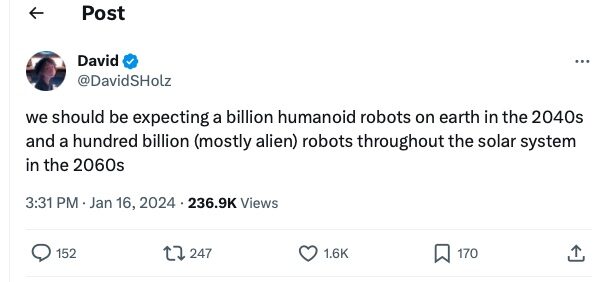Keeping up with X? If so, you might have seen a conversation between David Holz of Midjourney and Elon Musk of Tesla.
“We should be expecting a billion humanoid robots on earth in the 2040s and a hundred billion (mostly alien) robots throughout the solar system in the 2060s,” Holz suggested.
Musk replied, “Probably something like that, provided the foundations of civilization are stable.”
We don’t know where Holz got his numbers, but a Quora poster explained Musk’s thinking: “A critical mass of robots, he argues, is needed to create a network effect, driving innovation and ensuring affordability.”
How many humanoid robots?
There are currently about 1.47 billion cars in the world. There are about 1.72 billion TVs. If we assume that humanoid robots — once they reach their critical mass — will become as useful as cars and TVs, then they may also become as ubiquitous as cars and TVs. With that in mind, 1 billion sounds reasonable.
But are humanoid robots going to be as useful as cars and TVs? Or as affordable?
Musk’s Optimus is supposed to cost $20,000 when it gets into mass production. But it was supposed to get into mass production before now. However, Amazon sells several humanoid robots in that price range or even lower. Humanoid robots might be affordable by 2050.
Will they be useful?
The latest video demonstrating the capacity of Optimus shows, as so many robot videos do, that human beings are good at making videos. The most impressive part of the stars performance is that is picked up an egg without breaking it. Of course, we don’t know how many takes that required.
But nothing that the robot did was better than human or even especially useful. How much would you pay a human to complete the tasks in that video? Nothing. That is very different from cars and TVs.
Market forces will keep humanoid robots from hitting that billion unless the robots in question become a lot more practical soon.



